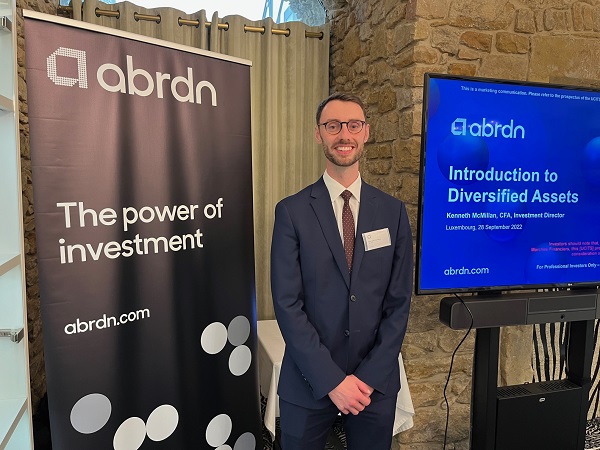 Kenneth McMillan, Investment Director of Diversified Assets at Aberdeen;
Credit: Chronicle.lu
Kenneth McMillan, Investment Director of Diversified Assets at Aberdeen;
Credit: Chronicle.lu
On Tuesday 28 September 2022, Aberdeen Standard Investments Luxembourg held an in-person Investment Lunch at the Hotel Le Place d'Armes in Luxembourg-Ville on the topic of Multi-Asset Allocation in a world of rising inflation.
With inflation reaching its highest level for over a decade and the conflict in Ukraine likely to impact energy pricing further, investors are seeking a better understanding of how funds might fare if inflation persists.
Aberdeen believes that some of their multi-asset solutions, especially those with direct inflation linkage to renewable infrastructure, are well positioned for the current environment.
Francois-Xavier Dirickx, Associate Director Business Development at Aberdeen in Luxembourg, welcomed the dozen-or-so attendees, mainly fund managers, and spoke briefly on introducing multi-asset management.
Kenneth McMillan, Investment Director of Diversified Assets, shared his latest views on how to face the current headwinds and presented the unique attributes of AS SICAV II - Multi-Asset Climate Opportunities (MACO) and AS SICAV I - Diversified Growth (DGF) funds.
He talked about Aberdeen's Diversified Growth Fund and Diversified Income Fund, stressing that they do not focus on traditional asset classes. He spoke about the current situation that presents an opportunity that can reduce reliance on equities and bonds. He also talked about returns coming from different revenue streams: traditionally, such asset classes are reserved for large investors, but Aberdeen offers a way in for smaller investors.
He said that there is strong demand on some of the asset classes, such as investing in precious metals investment companies.
In times of recession, he said that things change, such as many people deciding to return to university to gain additional qualifications.
For investors without a lot of liquid capital, he talked up the use of listed alternatives (such as wind farms, solar panels, etc.) that can help achieve fuller diversification. He showed, by the use of a graph, the growth of the listed alternatives market.
In terms of long-term track record, he presented Aberdeen's diversified growth strategy and pointed out how bad a year it has been for most asset classes.
As an example, he presented The Renewables Infrastructure Group and BioPharma Credit (healthcare royalties).
He then addressed alternative asset classes and mentioned emerging market local currency bonds, taking decisions on long-term effective returns.
He presented the team and described how they make extensive use of Aberdeen's resources across a wide array of asset classes. He talked about a flexible asset allocation exploiting the best opportunities, stressing that they invest for the long term. For example, in late 2021, they became worried about equities...
In their Diversified Growth fund (SICAV), he presented Aberdeen's one-year, three-year and five-year attributions, stressing that past performance does not predict future returns. Regarding the future outlook, he talked about a recession in both the United States and the European Union. In traditional asset classes, they see compelling opportunities in infrastructure, emerging market bonds, asset-backed securities, etc., emphasising that a diversified portfolio can protect against inflation, etc.
In conclusion, he stated that Aberdeen is conservative concerning traditional asset classes and operates a flexible investment approach with the potential to generate attractive returns over the next five years.








